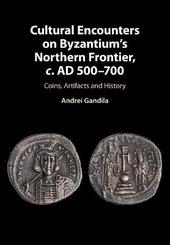
|
Cultural Encounters on Byzantium's Northern Frontier, c. AD 500-700: Coins, Artifacts and History
Paperback / softback
Main Details
| Title |
Cultural Encounters on Byzantium's Northern Frontier, c. AD 500-700: Coins, Artifacts and History
|
| Authors and Contributors |
By (author) Andrei Gandila
|
| Physical Properties |
| Format:Paperback / softback | | Pages:396 | | Dimensions(mm): Height 244,Width 170 |
|
| Category/Genre | Medieval European archaeology |
|---|
| ISBN/Barcode |
9781108455978
|
| Classifications | Dewey:949.602 |
|---|
| Audience | | Professional & Vocational | |
|---|
| Illustrations |
Worked examples or Exercises; 19 Maps; 47 Halftones, black and white; 22 Line drawings, black and white
|
|
Publishing Details |
| Publisher |
Cambridge University Press
|
| Imprint |
Cambridge University Press
|
| Publication Date |
19 August 2021 |
| Publication Country |
United Kingdom
|
Description
In the sixth century, Byzantine emperors secured the provinces of the Balkans by engineering a frontier system of unprecedented complexity. Drawing on literary, archaeological, anthropological, and numismatic sources, Andrei Gandila argues that cultural attraction was a crucial component of the political frontier of exclusion in the northern Balkans. If left unattended, the entire edifice could easily collapse under its own weight. Through a detailed analysis of the archaeological evidence, the author demonstrates that communities living beyond the frontier competed for access to Byzantine goods and reshaped their identity as a result of continual negotiation, reinvention, and hybridization. In the hands of 'barbarians', Byzantine objects, such as coins, jewelry, and terracotta lamps, possessed more than functional or economic value, bringing social prestige, conveying religious symbolism embedded in the iconography, and offering a general sense of sharing in the Early Byzantine provincial lifestyle.
Author Biography
Andrei Gandila is Assistant Professor of History and Director of Ancient and Medieval Studies at the University of Alabama, Huntsville. His numerous publications include articles in Byzantinische Zeitschrift, Dumbarton Oaks Papers, Numismatic Chronicle, Revue Numismatique, American Journal of Numismatics, and Archaeologia Bulgarica.
Reviews'The book's brisk survey of imported pottery, oil lamps, and jewelry documents the broad appeal of Roman culture in northern barbaricum, and provides context for the intensive investigation of gold, silver, and bronze coinage. Excavated coins document contractual exchange among political elites as well as low-level social interactions, yet their popular reception remained as exotic objects rather than economic currency. Richly documented and closely argued, this book offers a fresh historical analysis of emerging cultural identities in the early Balkans. Recommended.' M. Rautman, Choice 'Andrei Gandila has delivered a meticulously researched and presented book on a highly relevant and controversial topic ... Gandila is already known to scholarship through a number of studies on early Byzantine coins. By making his findings relevant in a particular context, the book will deservedly introduce his research to new audiences.' Julian Baker, Speculum 'Gandila's contribution to the study of frontier interactions is a welcomed addition to the study of late antiquity ... This work is well written, easy to read and provides a solid platform from which further and more specific studies may be undertaken.' David White, Journal of the Australian Early Medieval Association '... readers are ultimately rewarded with a richly detailed and impressive panorama of medieval history whose historical import is clearly manifest in Eastern Europe of the present.' Michael J. Decker, American Historical Review '... Andrei Gandila's monograph makes an impressive contribution to our understanding of the world they inhabited and the nature of their relations with the empire and the Lower Danube frontier. It should be essential reading for anyone studying diplomacy, frontiers and the history and archaeology of south-eastern Europe in the Early Byzantine / Early Medieval period.' Alexander Sarantis, The Royal Numismatic Society
|